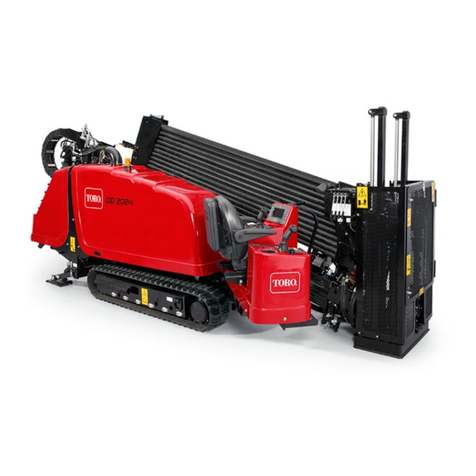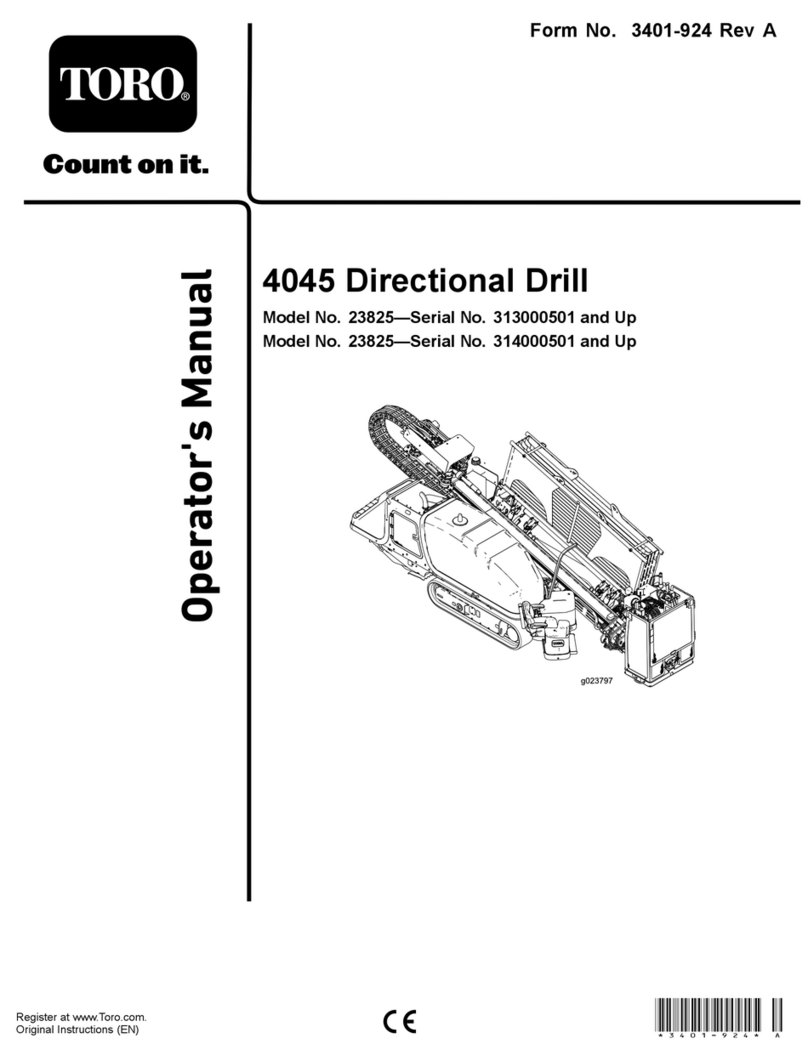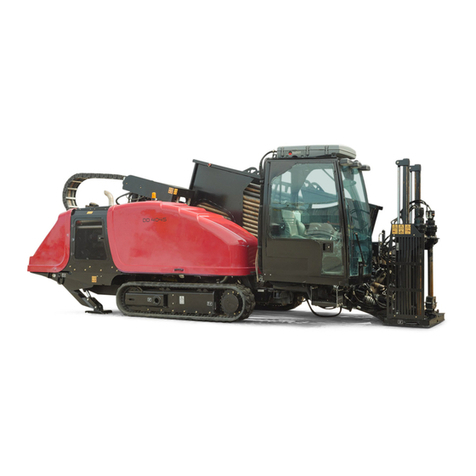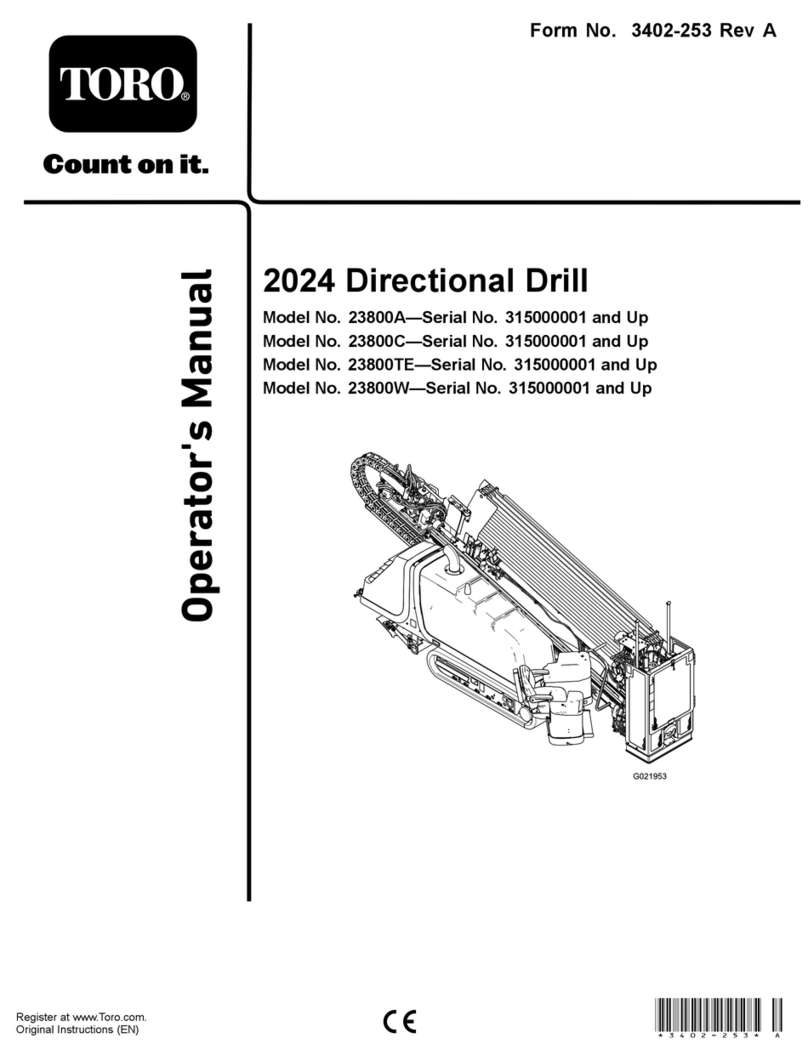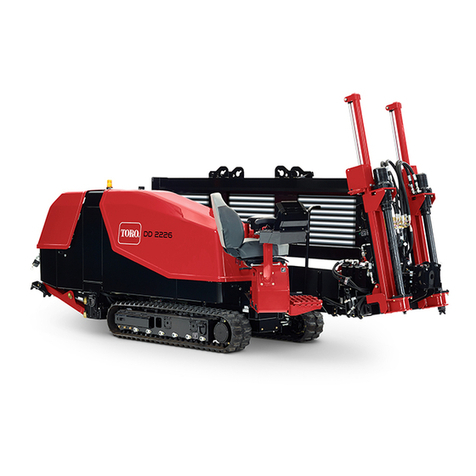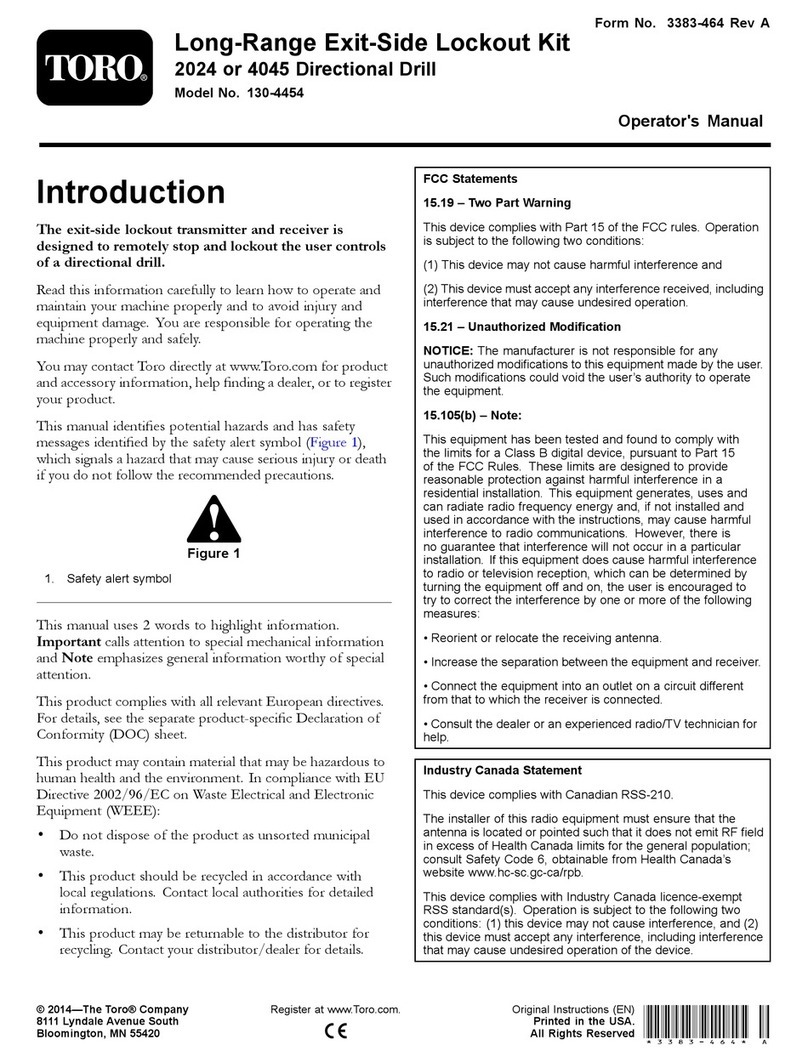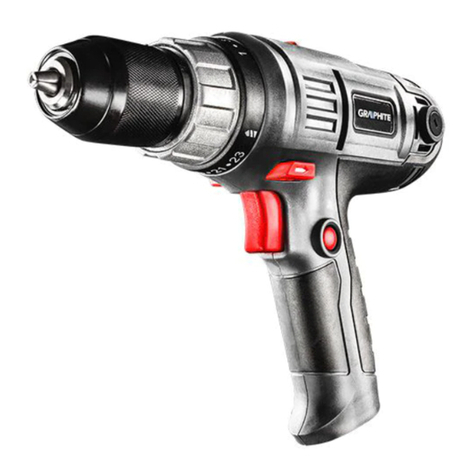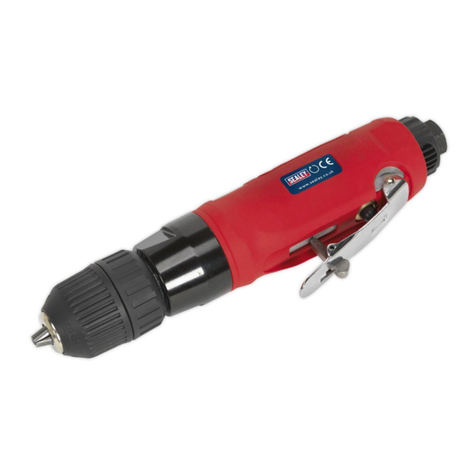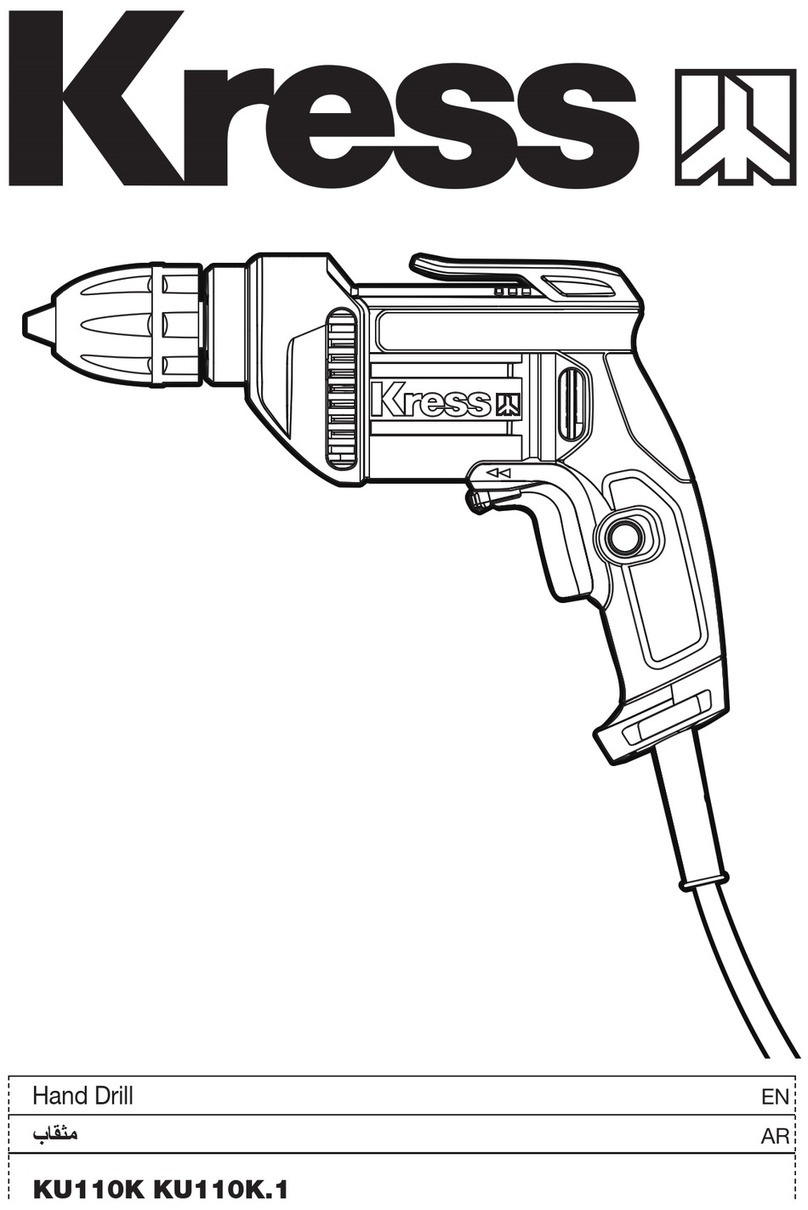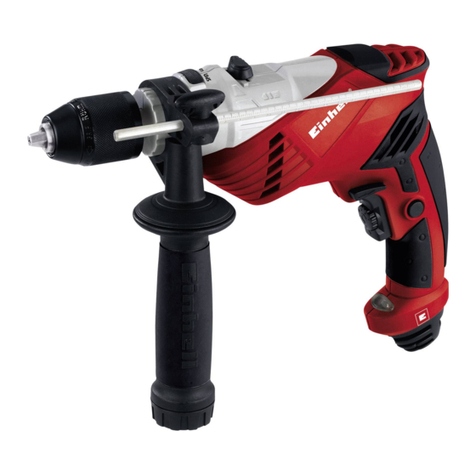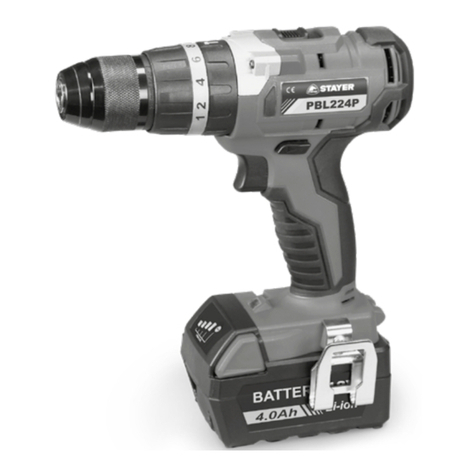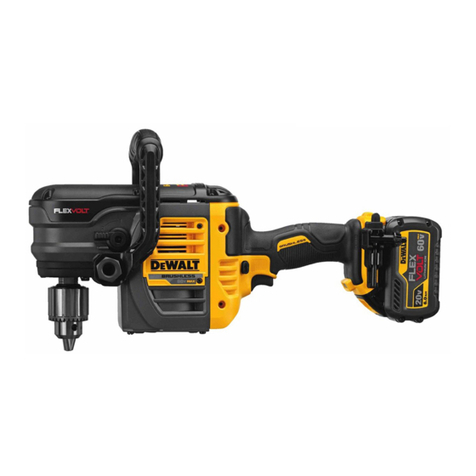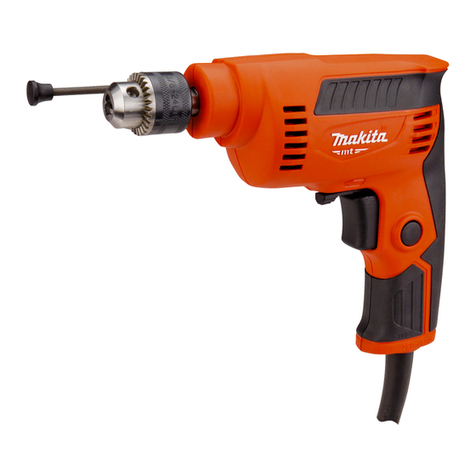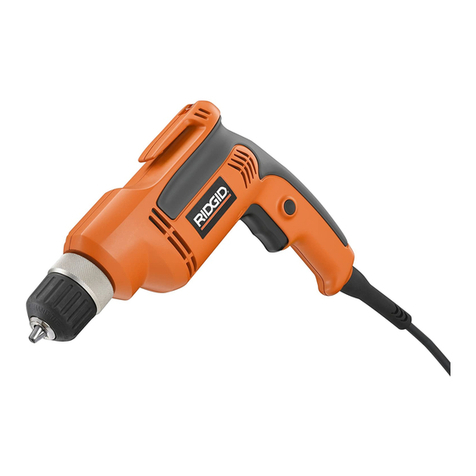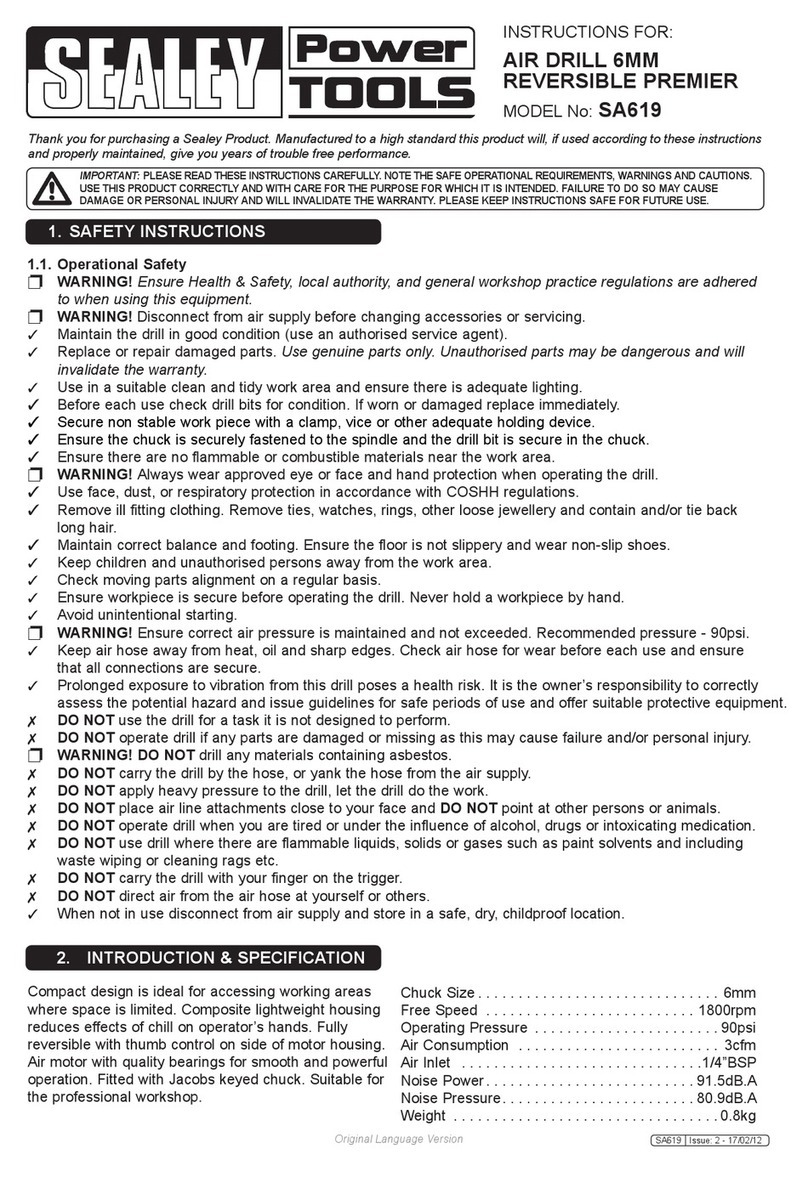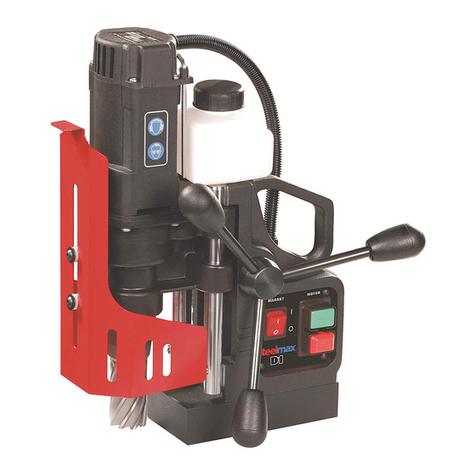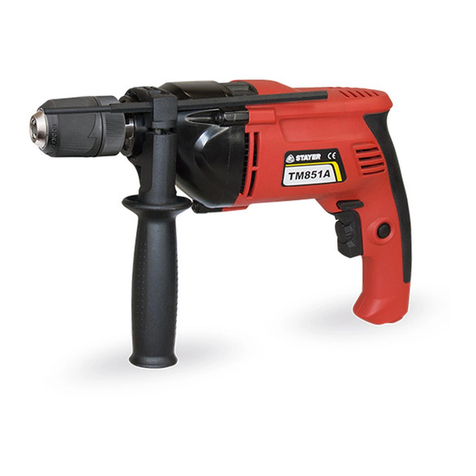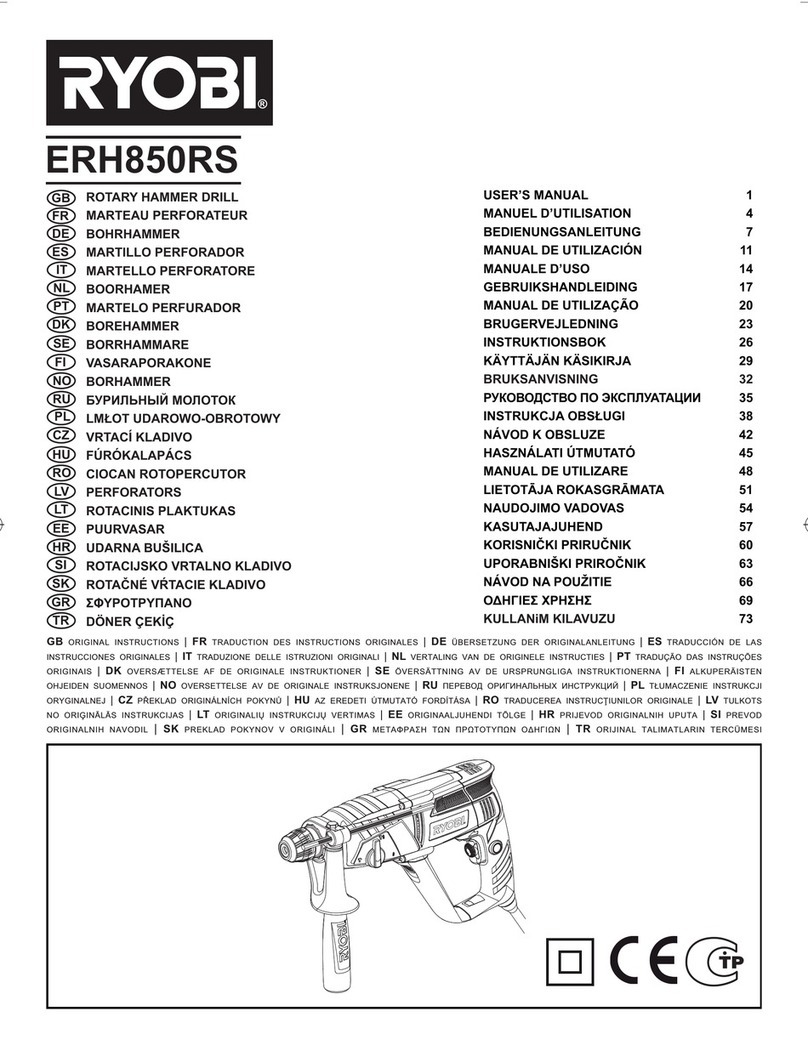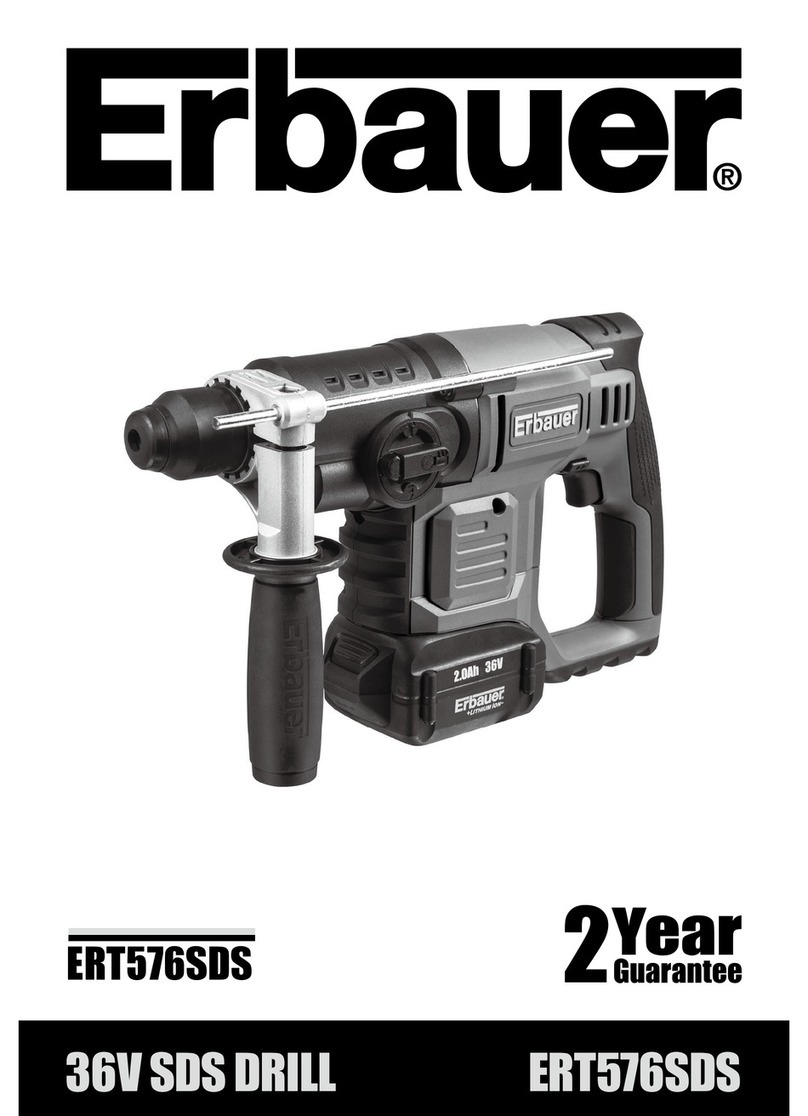Toro 2226 User manual

FormNo.3412-311RevA
2226DirectionalDrill
ModelNo.23803—SerialNo.400000000andUp
QuickStartGuide
Thismachineisaprototypeunit.
Safety
Improperuseormaintenancebytheoperatorcan
resultininjury.Toreducethepotentialforinjury,
complywiththesesafetyinstructionsandthesafety
instructionthroughoutthisdocument,denotedbythe
safety-alertsymbol,whichmeans:
Caution
,
W ar ning
,
or
Danger
—personalsafetyinstruction.Failureto
complywiththeinstructionmayresultinpersonalinjury
ordeath.
Thisproductiscapableofamputatinghandsandfeet.Follow
allsafetyinstructionstoavoidseriousinjuryordeath.
Theowner/usercanpreventandisresponsibleforaccidents
orinjuriesoccurringtopeople,ordamagetoproperty.
Important:Beforeoperatinginanareawith
high-voltagelinesorcables,contacta“One-CallSystem
Directory”service.IntheUSA,call811oryourlocal
utilitycompany.Ifyoudonotknowyourlocalutility
company’sphonenumber,callthenationalnumber
(USAandCanadaonly)at1-888-258-0808.Also,contact
anyutilitycompaniesthatarenotparticipantsofthe
“One-CallSystemDirectory”service.
•Readandunderstandthecontentsofthemanualbefore
youstartthemachine.Makesureeveryoneusingthis
machineknowshowtouseitandunderstandsthe
warnings.
•Donotputhandsorfeetnearmovingcomponentson
themachine.
•Keepbystandersasafedistancefromthemachine.
•Donotoperatemachinewithoutallguardsandother
safetyprotectivedevicesinplaceandworkingonthe
machine.
•Keepchildrenoutoftheoperatingareaandunderthe
watchfulcareofaresponsibleadultotherthanthe
operator.Neverallowchildrentooperatethemachine.
•Shutthemachineoffbeforeservicing,fueling,or
unplugging.
Training
•ReadtheOperator'sManualandothertrainingmaterial.
Note:Iftheoperator(s)ormechanic(s)cannotread
English,itistheowner'sresponsibilitytoexplainthis
materialtothem.
•Becomefamiliarwiththesafeoperationoftheequipment,
operatorcontrols,andsafetysigns.
•Alloperatorsandmechanicsshouldbetrained.The
ownerisresponsiblefortrainingtheusers.
•Donotletchildrenoruntrainedpeopleoperateorservice
theequipment.Localregulationsmayrestricttheageof
theoperator.
Preparation
•Evaluatetheterraintodeterminewhataccessoriesand
attachmentsareneededtoproperlyandsafelyperform
thejob.Onlyuseaccessoriesandattachmentsapproved
bythemanufacturer.
•Wearappropriateclothing;includingahardhat,safety
glasses,longpants,safetyshoes,andhearingprotection.
•Tiebacklonghair.Donotwearjewelry.Secureloose
clothing.
•Inspecttheareawheretheequipmentistobeusedand
ensurethatallobjectsareremovedfromthemachine
beforeuse.
•Useextracarewhenhandlingfuels.Theyareammable
andvaporsareexplosive.
–Useonlyanapprovedcontainer.
–Donotremovethefuelcaporaddfuelwiththe
enginerunning.Allowtheenginetocoolbefore
refueling.Donotsmokenearthemachinewhenthe
engineisrunning.
–Donotrefuelordrainthemachineindoors.
•Checkthattheoperator'spresencecontrols,safety
switches,andshieldsareattachedandfunctioning
properly.Donotoperatethemachineunlesstheyare
functioningproperly.
©2017—TheToro®Company
8111LyndaleAvenueSouth
Bloomington,MN55420
Registeratwww.T oro.com.OriginalInstructions(EN)
PrintedintheUSA
AllRightsReserved*3412-311*A

GeneralOperation
•Donotruntheengineinanenclosedarea.
•Donotoperatewithouttheguardssecurelyinplace.Be
sureallinterlocksareattached,adjusted,andfunctioning
properly.
•Donotchangetheenginegovernorsettingoroverspeed
theengine.
•Keepawayfrommovingmachinepartsandpipes.
•Donotoperatethemachinewhenillorunderthe
inuenceofalcoholordrugs.
•Donotleavethemachinerunningunattended.Stopthe
engineandremovethekeybeforeleaving.
•Locatethepinch-pointareasmarkedonthemachineand
attachmentsandkeephandsandfeetawayfromthese
areas.
•Lightningcancausesevereinjuryordeath.Iflightning
isseenorthunderisheardinthearea,donotoperate
themachine;seekshelter.
DrivingSafety
Youdrivethemachinetoandfromtheworksitewiththeuse
ofatetheredremote.Whendrivingthemachine,observethe
followingsafetyprecautions:
•Operatethedrivependantalongsidethemachineoutside
ofthedangerzone(Figure1).
•Keepallbystandersawaywhilemovingthemachine.
•Donotcarrypassengersonthemachine.
•Watchfortheturning-radiussweepofthedrillframe,as
thecenteroftheturningradiusistheendofthetrack.
•Movingthemachinewiththetetheredremotecan
beerratic;moveslowlywhenusingtheremotefor
movement.
•Usecarewhenloadingorunloadingthemachineontoa
trailer.
•Watchfortrafcwhencrossingroadways.
•Checkforoverheadclearances(i.e.branches,doorways,
electricalwires)beforedrivingunderanyobjectsanddo
notcontactthem.
•Whendrivingonaslope,theoperatorshouldbeup-slope
fromthemachine.
Thefollowingillustrationdisplaysthesafedistancethatall
individualsmustmaintainwhilemovingthemachine.
1
23
3G021 118
X
1
1
4
4
4
g021118
Figure1
DrivingDangerZone
1.1.8m(6ft)safetydistance3.Turning-radiuscenter
2.Operator4.2.4m(8ft)safetydistance
2

DrillingSafety
Ensurethatnooneapproachesapipewhileitisspinning.
Thepipecansnagonclothingandcauseamputationor
death.AlwaysengagetheExit-sideLockoutbeforeanyone
approachesthefrontofthemachine,bit,reamer,orpipe.
DrillingDangerZone
Thedangerzoneistheareawithinandaroundthemachine
whereapersonisexposedtotheriskofinjury.Thisproximity
includeswhereapersoncanbereachedbyoperational
movementofthemachine,itsworkingdevices,auxiliary
equipment,orswinging/fallingequipment.
Note:Thedangerzonedenestheamountofspace
neededforsafedrillingoperation,includingmovementof
thecarriage.
Thefollowingillustrationdisplaysthesafedistancethatmust
bekeptbyallindividualswhiledrilling.
g194261
Figure2
DrillingDangerZone
1.3m(10ft)safetydistance2.1.8m(6ft)safetydistance
DrillingNearUtilityLines
Whenworkingnearburiedutilitylines,safetyprecautions
mustbetaken.
Important:Beforeoperatinginanareawith
high-voltagelinesorcables,contacta“One-Call
SystemDirectory”service.IntheUSA,call811or
yourlocalutilitycompany.Ifyoudonotknowyour
localutilitycompany’sphonenumber,callthenational
number(USAandCanadaonly)at1-888-258-0808.Also,
contactanyutilitycompaniesthatarenotparticipants
ofthe“One-CallSystemDirectory”service.Please
refertoDrillingNearUtilityLines(page3)formore
information.
3

UtilityLineColor
Refertothefollowingtablefortheproperutilitylineandthecorrespondingutilitylinecolor(USAandCanada).
UtilityLineUtilityLineColor
ElectricRed
Telecommunication,alarmorsignal,cables,orconduitOrange
Naturalgas,oil,steam,petroleum,orothergaseousorammable
material
Yellow
SeweranddrainGreen
DrinkingwaterBlue
Reclaimedwater,irrigation,andslurrylinesPurple
TemporarysurveymarkingsPink
ProposedexcavationlimitsWhite
ElectricalLineSafety
WARNING
Ifyouleavetheseatofthemachineortouch
anypartofthemachinewhenitischargedwith
electricity,seriousinjuryordeathcouldresult.
Donotleavetheseatofthemachineifthemachine
ischargedwithelectricity.
Intheeventofanelectricstrikethatchargesthemachine,the
Zap-AlertElectricStrikealarmsystemwillsoundforaslong
asthemachineischargedwithpower.
Note:Immediatelycontacttheproperemergencyandutility
authoritiestosecuretheareainthecasethatthemachineis
chargedandyoucannotleavetheseatofthemachine.
Note:Itispossibletostrikeautilitylinewithoutthemachine
becomingcharged.
•Thealarmwillsoundifthedrillcontactsanelectrical
powersource.
•Itislikely(butnotalwaysthecase)thatthepower-source
interrupterorbreakerwilltrip,buttoensureyoursafety,
considerthatthemachinemaybeconductingelectricity.
•Donotattempttoleavethemachine.
Note:Youwillbesafeaslongasyoudonotleavethe
seatofthemachine.
•Touchinganypartofthemachinemaygroundyou.
•Donotallowanotherindividualtotouchorapproach
themachinewhencharged.
•Thealarmmaysoundifacommunicationlineisbroken,
butuntilyouarecertain,youmustconsiderthealarmto
beanelectricstrike.
GasLineSafety
WARNING
Ifyoudamageagasline,animmediateexplosion
andrehazardcouldoccur.Leakinggasisboth
ammableandexplosiveandmaycauseserious
injuryordeath.
•Donotsmokewhileoperatingthemachine.
•Shutoffthemachineandremovethekey.
•Removeallindividualsfromtheworkarea.
•Immediatelycontacttheproperemergencyand
utilityauthoritiestosecurethearea.
WaterLineSafety
Ifyoudamageawaterline,apotentialoodhazard
couldoccur.
•Shutoffthemachineandremovethekey.
•Removeallindividualsfromtheworkarea.
•Immediatelycontacttheproperemergencyand
utilityauthoritiestosecurethearea.
CommunicationLineSafety
Important:RefertoElectricalLineSafety(page4)ifa
communicationlineisdamaged.
CAUTION
Ifyoudamagetheber-opticcableandlookinto
theexposedhighly-intenselight,youmayharm
youreyes.
•Shutoffthemachineandremovethekey.
•Removeallindividualsfromtheworkarea.
•Immediatelycontacttheproperemergencyand
utilityauthoritiestosecurethearea.
4

MaintenanceandStorage
•Donottouchpartswhichmaybehotfromoperation.
Allowthemtocoolbeforeattemptingtomaintain,adjust,
orservice.
•Lowerthethrustframe,stoptheengine,andremove
thekey.Waitforallmovementtostopbeforeadjusting,
cleaning,orrepairing.
•Cleandebrisfromattachments,drives,mufers,and
enginetohelppreventres.Cleanupoilorfuelspillage.
•Lettheenginecoolbeforestoringanddonotstorenear
ame.
•Donotstorefuelnearamesordrainindoors.
•Parkthemachineonlevelground.
•Donotallowuntrainedpersonneltoservicethemachine.
•Carefullyreleasepressurefromcomponentswithstored
energy.
•Keephandsandfeetawayfrommovingparts.Ifpossible,
donotmakeadjustmentswiththeenginerunning.
•Disconnectthebatterybeforemakinganyrepairs.
Disconnectthenegativeterminalrstandthepositive
last.Reconnectpositiverstandnegativelast.
•Chargebatteriesinanopen,wellventilatedarea,away
fromsparkandames.Unplugthechargerbefore
connectingordisconnectingitfromthebattery.Wear
protectiveclothinganduseinsulatedtools.
•Batteryacidispoisonousandcancauseburns.Avoid
contactwithskin,eyes,andclothing.Protectyourface,
eyes,andclothingwhenworkingwithabattery.
•Batterygasescanexplode.Keepcigarettes,sparksand
amesawayfromthebattery.
•Keepallpartsingood-workingconditionandallhardware
tightened.Replaceallwornordamageddecals.
•Ifanymaintenanceorrepairrequirestheframetobein
theraisedposition,securetheframeintheraisedposition
withthehydrauliccylinderlock.
•Keepnutsandboltstight.
•Keepequipmentingoodcondition.
•Donottamperwithsafetydevices.
•Keepthemachinefreeofgrass,leaves,orotherdebris
build-up.Cleanupoilorfuelspillage.Allowthemachine
tocoolbeforestoring.
•Useextracarewhenhandlingfuels.Theyareammable
andvaporsareexplosive.
–Useonlyanapprovedcontainer.
–Donotremovethefuelcaporaddfuelwhenthe
engineisrunning.Allowtheenginetocoolbefore
refueling.Donotsmoke.
–Donotrefuelthemachineindoors.
–Donotstorethemachineorfuelcontainerinside
wherethereisanopename,suchasnearawater
heaterorfurnace.
–Donotllacontainerwhileitisinsideavehicle,
trunk,pick-upbed,oranysurfaceotherthanthe
ground.
–Keepcontainernozzleincontactwiththetankduring
lling.
•UseonlygenuineTororeplacementpartstoensurethat
originalstandardsaremaintained.
•Keepyourbodyandhandsawayfrompinholeleaks
ornozzlesthatejecthighpressurehydraulicuid.Use
cardboardorpapertondhydraulicleaks;donotuse
yourhands.Hydraulicuidescapingunderpressurecan
penetrateskinandcauseinjuryrequiringsurgerywithina
fewhoursbyaqualiedsurgeonorgangrenemayresult.
5

ProductOverview
g194439
Figure3
1.Drillcarriage6.RightStabilizer
2.Zapalertstrobe7.Rearhood
3.Operatorseat8.Fronthood
4.Controlpanel9.Track
5.Thrustframe
g194440
Figure4
1.Pipeholder3.Leftstabilizer
2.Stakedownplate
6

g194441
Figure5
1.Drillcarriage4.Upperwrench
2.Drillspindle5.Lowerwrench
3.Thrustframe6.Pipewiper
7

Operation
UnderstandingHorizontal
DirectionalDrilling
Horizontaldirectionaldrillingisaprocessusedfordrillinga
horizontalborethroughthesoilandunderobstructionssuch
asroads,buildings,bodiesofwater,etc.Onceyoudrillthe
bore,youpullbacktheutilitylinesorpipesthroughthebore
andconnectthemasneeded.Becauseitdoesnotrequire
verymuchdisturbanceofthesurface,installationofutilities
usingdirectionaldrillingpreservestheenvironmentandsaves
bothtimeandmoneyovertraditionalinstallationmethods
suchastrenching.
Wheninstallingcablingorpipeusingadirectionaldrill,you
completethefollowingsteps:
1.Gathersiteinformation.
Beforeoperatinginanareawithhigh-voltagelinesor
cables,contacta“One-CallSystemDirectory”service.
IntheUSA,call811oryourlocalutilitycompany.If
youdonotknowyourlocalutilitycompany’sphone
number,callthenationalnumber(USAandCanada
only)at1-888-258-0808.Also,contactanyutility
companiesthatarenotparticipantsofthe“One-Call
SystemDirectory”service.PleaserefertoDrilling
NearUtilityLines(page3)formoreinformation.
Beforefullyplanningthebore,youmustgather
informationaboutthejobsitesuchasthelocationof
otherutilities,obstaclesatthesite,andwhatregulations
andpermitsyouwillneedtocompletethejob;referto
GatheringSiteInformation(page9).
2.Planthebore.
Beforeyoucandrill,youmustrstplantheborepath
basedontheinformationyougathered.Referto
PlanningtheBorePath(page11).
3.Preparethejobsiteandthemachine.
Beforedrilling,youpreparethejobsitewithanentry
point,depth-gaugehole(optional),andanexithole.
Youalsoneedtodrivetheunittothesite,setitupfor
drilling,andconnectittoadrilling-uidmixer.
Note:Whendrilling,youconnectthemachinetoa
drilling-uidmixerthatmixeswaterwithbentonite
clayandotheringredients.Themachinepumpsthis
mixture,referredtoasdrillinguidor“Mud”,through
thedrillpipeandoutthedrillbit.Thedrillinguid
lubricatesthebit,helpstoholdtheboreopenwhile
drilling,andmixeswiththespoils,ushingthemout
oftheborethroughtheentrypoint.
RefertoPreparingtheJobSiteandtheMachine(page
18)forinstructionsonpreparingthejobsiteandthe
machine.
4.Drillthebore.
Youdrilltheboreinthreestages:
A.Entry
Intheentryphaseofthebore,youpushthedrill
bitandheadintothegroundatanangleofupto
16degrees.Afterpushinginoneormorepipes,
youbegindrillingdownandforwarduntilyou
reachthedesireddepthordepth-gaugehole(if
used).
B.HorizontalReach
Afterreachingthedesireddepth,youpushthe
bitforward,steeringthebittoahorizontaldepth.
Thedrillbitemitsaradiosignalfromthesonde
housing,whichallowsacrewmemberonthe
surfacetotrackthelocationanddepthofthehead
usingthesondereceiverasyoudrillandsteerit
alongaplannedroute.
C.Exit
Onceyouhaveattainedtheplannedhorizontal
reach,yousteertheheadupatananglesimilar
toyourentryanglebringingthebitintotheexit
holeortrench.
RefertoDrillingtheBore(page25).
5.Backreamtheboreandpullbackthecablingor
pipe.
Afterenteringtheexithole,theendcrewdetachesthe
drillbitandsondehousingfromthedrillpipe.Inits
place,theyattachareamingbitandtheendofthecable
orpipetobepulledthroughthebore.Thereaming
bitisdesignedtoenlargetheboreasyoupullitback.
Asbefore,youpumpdrillinguidthroughthepipe
tothereamingbitasyoupullthecableorpipeback
throughtheboretolubricatethereamerandallow
thecableorpipetoslideeasilythroughthebore.You
continuepullingthepipebackuntilthereamerreaches
thedepth-gaugeholeorexitsattheentrypoint.There
youremovethereamerandproductfromthedrillpipe,
pullingthepipetherestofthewaybacktothemachine.
RefertoBackreamingandPullback(page28)for
instructionsonbackreamingandpullingcableorpipe.
6.Finishtheboreandleavethejobsite.
Aftercompletingtheoperation,youneedtodisconnect
andcleanthemachineandloaditonthetrailer;refer
toFinishingtheJob(page30).
8

GatheringSiteInformation
PlanningtheInitialRoute
Beforeyoucanbeginboring,youneedtoplantherouteyou
willboreandprepareasfollows:
•Createabasicplanforthebore,mappingoutthe
proposedroute.
–Noteanyobstacleswhichmayaffecttheboresuchas
largetrees,bodiesofwater,buildings,etc.
–Plantherouteoftheboretoavoidasmanyobstacles
aspossible.
–Determinethedepthofanybodiesofwatertobe
crossedtoensurethatyoucangetdeepenoughunder
them.
•Determinethedepthyouneedtoinstallthematerialat
andtheminimumbendradiusbothofthedrillpipeand
ofthematerialbeinginstalled.Thiswillseriouslyaffect
howlongtheboreneedstobeandatwhatangleyoucan
beginandend;refertoPlanningtheBorePath(page11).
•Havetheareaoftheboremarkedforutilitylines(inthe
UScall811).Ensurethatalllinesaremarkedonyour
blueprints/boreplanaswell.
•Contactthelocalauthoritiestoarrangeforanypermits
andtrafccontrolthatyouwillneedtoconductthejob.
InspectingtheProposedJobSite
Physicallyinspectthesiteasfollows:
•Notetheterrain,slopes,valleys,hills,andanyfeatures
notplannedforpreviously.
Determinethedegreeofslopeatboththeproposedentry
pointandexitpoint.
•Determinewhatthesoiltypesareintheareaand,if
possible,whattheyareatthedepthyouwillbeboring.
Youmayneedtodigtestholesatintervalsalongthebore
pathtofullydeterminethis.
•Walktheareaoftheborelookingforanypossible
unmarkedobstructions.Lookformanholes,pedestals,
oldfoundations,etc.
•Identifyallhazardsofwhichyouwillbepassingwithin
3m(10ft).
DANGER
Contactingundergroundhazardswiththe
machinewhiledrillingorreamingcancause
explosion,electrocution,breathingproblems,
severetrauma,anddeathtoyouorbystanders.
–Ensurethatallpersonnelatthejobsitewear
personalprotectiveequipmentincluding
ahardhat,eyeprotection,andhearing
protection.
–Keepbystandersandspectatorsawayfrom
thejobsite,includingthecompletebore
path.
–Locateandexposeallelectricandgaslines
thatyouwillbecrossingbycarefulhand
digging.
–EnsurethatyouusetheZap-Alertsystem
wheneveroperatingthemachine.
Commonhazardsincludethefollowing:
–Gaslines
DANGER
Drillingintoagaslinecancauseanexplosion
orre,burning,injuring,orkillingyouor
othersinthevicinityofthebreak.
◊Donotsmokeorhaveanysourceofame
neargaslinesorateitherendofabore
thatwillbecrossingagasline.
◊Keepbystandersandspectatorsaway
fromthejobsite,includingthecomplete
borepath.
◊Locateandexposeallgaslinesthatyou
willbecrossingbycarefulhanddigging.
◊Havethegascompanyturnoffthegas
toanylinesyouwillbecrossingbefore
drilling.
◊Usethereceivertotracktheexactposition
ofthedrillheadwhenapproachinggas
lines.
9

–Electricalpowerlines
DANGER
Drillingintoanelectricpowerlinewillcause
themachinetobecomeelectriedandmay
electrocuteyouoranybystanders.
◊Keepbystandersandspectatorsaway
fromthejobsite,includingthecomplete
borepath.
◊Locateandexposeallelectriclinesthat
youwillbecrossingbycarefulhand
digging.
◊Havetheelectriccompanyturnoffthe
powertoanylinesyouwillbecrossing
beforedrilling.
◊Usethereceivertotracktheexact
positionofthedrillheadwhen
approachingelectriclines.
◊Beforedrilling,setupandusethe
Zap-Alertsystemwhichisdesignedto
notifyinthecaseofanelectricstrikeand
electricallyisolatethemachineoperator
fromthemachine.IftheZap-Alertalarm
triggers,stopwhatyouaredoinganddo
notleavetheoperator’sposition.Refer
toDeployingtheZap-AlertSystem(page
24)fordetailedinstructionsonusingthe
Zap-Alertsystem.
–Crystallinesilicaandotherdust
Ifyouwillbedrillingthroughorcuttingconcrete,
sand,orothersubstancesthatcreatedustsorfumes,
youneedtoensurethatyouandallworkerswear
breathingprotectiontoprotectyourlungsfromthe
dust.
WARNING
Machiningorhandlingstone,masonry,
concrete,metal,andothermaterialscan
generatedust,mists,andfumescontaining
chemicals,suchassilica,knowntocause
seriousorfatalinjuryorillness,suchas
respiratorydisease,silicosis,cancer,birth
defects,orotherreproductiveharm.
◊Controldust,mist,andfumesatthe
sourcewherepossible.Watershouldbe
usedfordustsuppressionwhenfeasible.
◊Usegoodworkpracticesandfollowthe
recommendationsofthemanufactureror
suppliers,OSHA,andotheroccupational
andtradeassociations.
◊Whenthehazardsfrominhalationcannot
beeliminated,theoperatorandany
bystandersshouldweararespirator
approvedbyOSHAforthematerialbeing
handled.
WARNING
Silicosis W ar ning:
Grinding,cutting,or
drillingstone,masonry,concrete,metal,
andothermaterialswithsilicaintheir
compositionmaygiveoffdustormist
containingcrystallinesilica.Silicaisa
basiccomponentofsand,quartz,brick,
clay,granite,andnumerousotherminerals
androcks.Repeatedand/orsubstantial
inhalationofairbornecrystallinesilicacan
causefatalrespiratorydiseases,including
silicosis.Inaddition,someotherauthorities
havelistedrespirablecrystallinesilicaasa
substanceknowntocausecancer.When
cuttingsuchmaterials,followrespiratory
precautions.
10

PlanningtheBorePath
Beforesettingupthejobsite,youneedtoplantheborepath,
includingthefollowing:
1
2
3
4
5g021764
g021764
Figure6
1.Boreentry4.Obstacle
2.Beginning-of-bore-at-depthpoint5.End-of-bore-at-depthpointandboreexit
3.Boredepth
•Boreentry
Theisthelocationwhereyousetupthemachineandthe
drillbitenterstheground.Dependingonconditions,this
willtypicallybesetback9to15m(30to50ft)fromthe
beginning-of-the-bore-at-depthpoint.
•Beginning-of-bore-at-depthpoint
Thisisthepointwhereyouwanttheutilitylineorpipeto
endafterinstallationiscomplete.Itistypicallythepointat
whichtheborelevelsoutandbeginstoborehorizontally.
Thismaybethesameastheentrypoint,oryoumaydiga
separatedepth-gaugeholeatthispoint(Figure6).
•Boredepth
Thisthedepthatwhichyouwanttoinstalltheutility
lineorpipe.Thismachineisdesignedprimarilyfor
installationsbetween1and3m(3.5to10ft).
•Obstaclesinthepath
Itisimportanttoknowwheretheknownobstaclesare
thatyouwillneedtosteeraroundorunderbeforestarting
sothatyoucanplanwheretobeginsteeringpriorto
reachingtheobstacle.
•End-of-bore-at-depthpoint
Thisisthepointwhereyouwanttheutilitylineorpipe
tobeginafterinstallationiscomplete.Oftenthiswillalso
betheboreexit.
•Boreexit
Thisisthelocationwherethedrillheadwillexitthe
groundandthepointatwhichyouwillpulltheutilitylines
orpipeintothebore.Ifthispointwillbeatthesurface
insteadofatinstallationdepth,youwillneedtodetermine
thedistancefromtheend-of-bore-at-depthlocation
neededforsteeringthedrilltothesurface,typically9to15
m(30to50ft)fromtheend-of-the-bore-at-depthpoint.
DeterminingtheBoreEntryPoint
Oneofthemorechallengingaspectsofplanningthebore
pathistodeterminetheentrypointofthebore.Youneedto
takethefollowingtraitsintoaccountwhendeterminingthe
locationoftheentrypoint:
•Boredepth
Thisthedepthatwhichyouwanttoinstalltheutility
lineorpipe.Thismachineisdesignedprimarilyfor
installationsbetween1and3m(3.5to10ft).
•Pipeandmaterialexibility
The3m(10ft)pipesusedonthismachinecanextoan
8%pitchoverthelengthofthepipe;thisequatestoa
bendofnomorethan20cm(8inches)offofastraight
path(Figure7).
Important:Ifyousteerthepipetobendsharper
than20cm(8inches)perpipe,youmaydamagethe
pipesandtheirconnections.Youmustalsomake
steeringchangesgraduallyovertheentirelengthof
eachpipe.Ifyousteerthewhole20cm(8inches)
inonly25to50cm(1to2ft)oftravel,youwill
permanentlydamagethepipes.
11

1
g021765
g021765
Figure7
1.20cm(8inches)
Thisexibilityisoftenratedinmaterialsasaminimum
bendradius,whichistheradiusofthecircleformedifthe
materialorpipes,connectedtogether,werebenttoform
agiantcircle.Theminimumradiusofacirclemadewith
thepipeusedwiththismachineis36.6m(102ft).
•Entrypitch
Theentrypitchistheangleatwhichthemachine
enterstheground.Withthetracksonlevelground,the
stabilizersdown,andthestake-downplateontheground,
thedrillframeangleisabout15degreesora27%pitch.
Thispitchwillchangedependingontheslopeofthe
groundandotherfactorsofthejobsite.Youcanalso
reducethispitchabitbybuildingupthegroundunder
thestake-downplatebeforepositioningthemachine.
Youcandeterminetheactualpitchofthedrillframeby
placingthedrillbitandsondehousingontheframeand
thenusethereceivertodisplaythepitch.
Thesteeperyourentrypitchis,thedeeperyourborewill
havetobeduetothelimitationsofthepipeexibility.
Typicallyyouneedtoinsertthedrillandatleast1/3ofa
pipeintothegroundbeforeyoucanstartsteeringtoward
thebeginningoftheborepoint.Figure8,Figure9,and
thefollowingtableillustratetherelationshipbetween
entrypitchanddepth.
1
23
g021766
g021766
Figure8
1.26%pitch3.76cm(30inches)
2.3m(10ft)
23
g021767
1
g021767
Figure9
1.18%pitch3.53cm(21inches)
2.3m(10ft)
12

Note:Thedepthsgiveninthefollowingtablearefor3m(10ft)ofcombineddrillheadandpipe.Asyousteerup,the
pitchofthesteeredsectionwillchangeandcanbemonitoredwiththereceiver.Usethefollowingtabletoidentifyhow
manylengthsofpipewillbenecessarytoinsertandsteertothebeginningpointandhelpyouchooseanentrypoint.
PitchDepthChangeper10feetPitchDepthChangeper10feet
1%2cm(1inch)26%76cm(30inches)
2%5cm(2inches)27%79cm(31inches)
3%10cm(4inches)28%81cm(32inches)
4%13cm(5inches)29%84cm(33inches)
5%15cm(6inches)30%86cm(34inches)
6%18cm(7inches)31%91cm(36inches)
7%20cm(8inches)32%94cm(37inches)
8%25cm(10inches)33%97cm(38inches)
9%28cm(11inches)34%99cm(39inches)
10%30cm(12inches)35%102cm(40inches)
11%33cm(13inches)36%104cm(41inches)
12%36cm(14inches)37%107cm(42inches)
13%39cm(15inches)38%109cm(43inches)
14%43cm(17inches)39%112cm(44inches)
15%46cm(18inches)40%114cm(45inches)
16%48cm(19inches)41%117cm(46inches)
17%51cm(20inches)42%117cm(46inches)
18%53cm(21inches)43%119cm(47inches)
19%56cm(22inches)44%122cm(48inches)
20%61cm(24inches)45%124cm(49inches)
21%64cm(25inches)46%127cm(50inches)
22%66cm(26inches)47%130cm(51inches)
23%69cm(27inches)48%133cm(52inches)
24%71cm(28inches)49%135cm(53inches)
25%74cm(29inches)50%137cm(54inches)
Allmeasurementsareapproximateandwillvarydependingonsoilconditions.
Note:ThesevaluesandmorecanbefoundintheDriller’sHandbook&DailyLogbyDigitalControlIncorporated.
13

Giventheaboveinformation,youcancalculatethenumberof
rodsrequiredtoreachyourbeginningpointattheappropriate
depth.Tororecommendsthatyoustarttheentrypointa
distancebackfromyourbeginning-at-depthpointbythe
samedistanceasthelengthofpipesyouwillneedtoreach
thatpoint.Thiswillensurethatyouhaveenoughextraspace
soyouwillnotneedtoover-steeranddamagethepipes.
Thefollowingexampleillustratestheprocessgivenan
installationusingthemaximumentrypitchofthemachine
(26%)onlevelground:
•Youinserttherst3m(10ft)ofdrillbit/pipeintothe
groundwithnosteering.Theendofthedrillbitwillbe
76cm(30inches)deep(Figure7).
1
4
2
3
5
g021768
7
6
g021768
Figure10
1.26%pitch4.185cm(73inches)7.14.7m(45ft)
2.76cm(30inches)5.203cm(80inches)
3.142cm(56inches)6.208cm(82inches)
•Youbeginsteeringupforthenext3m(10ft),pushingthe
pipesinatthemaximumpitchchangeof8%.Thisresults
inachangeofpitchfrom26%atthebeginningofthe3m
(10ft)to18%attheendofthe3m(10ft)foranaverage
pitchof22%.Giventhat,thedrillheadlowersanother66
cm(26inches)andisnow142cm(56inches)deep.
•Continuingsteeringupforthenext3m(10ft)atan8%
pitchchange,yourpitchwillchangefrom18%to10%
foranaveragepitchof14%.Giventhat,thedrillhead
lowersanother43cm(17inches)andisnow185cm(73
inches)deep.
•Continuingsteeringupforthenext3m(10ft)atan8%
pitchchange,yourpitchwillchangefrom10%to2%for
anaveragepitchof6%.Giventhat,thedrillheadlowers
another18cm(7inches)andisnow203cm(80inches)
deep.
•Levelingthedrillheadfrom2%to0%takeslessthan1.5
m(5ft)moreforanaldepthof208cm(82inches).
Reachingthisnalpointtookfourandahalf,3m(10ft)
pipes.Soforthisexampleyourentrypointshouldbe
14.7m(45ft)backfromthebeginning-at-depthpointof
yourinstallation.
14

Thefollowingexampleillustratestheprocessgivenan
installationusingthemachineatan18%pitchonlevel
ground:
•Youinserttherst3m(10ft)ofdrillbit/pipeintothe
groundwithnosteering.Theendofthedrillbitwillbe
53cm(21inches)deep(Figure11).
12
34
g021769
6
5
g021769
Figure11
1.18%pitch3.96cm(38inches5.119cm(47inches)
2.53cm(21inches)4.114cm(45inches)6.10.6m(35ft)
•Youbeginsteeringupforthenext3m(10ft),pushingthe
pipesinatthemaximumpitchchangeof8%.Thisresults
inachangeofpitchfrom18%atthebeginningofthe3m
(10ft)to10%attheendofthe3m(10ft)foranaverage
pitchof14%.Giventhat,thedrillheadlowersanother43
cm(17inches)andisnow96cm(38inches)deep.
•Continuingsteeringupforthenext3m(10ft)atan8%
pitchchange,yourpitchwillchangefrom10%to2%for
anaveragepitchof6%.Giventhat,thedrillheadlowers
another18cm(7inches)andisnow114cm(45inches)
deep.
•Levelingthedrillheadfrom2%to0%takeslessthan1.5
m(5ft)moreforanaldepthof119cm(47inches).
Reachingthisnalpointtookthreeandahalf,3m(10
ft)pipes.Soforthisexampleyourentrypointshouldbe
10.6m(35ft)backfromthebeginning-at-depthpointof
yourinstallation.
Important:Youcanusetheinformationcontainedin
thissectiontodetermineboththespaceneededtosteer
uptotheexitpointifneededandalsotosteeraround
obstacles.
MappingtheBore
Withtheinformationyougatheredpreviously,mapoutthe
routeofthebore,identifyingthefollowingsothatyoucan
markthesitelater:
•Entrypoint
•Locationofthemachineandsupportingequipment
•Beginningofboreatdepth
•Anyobstaclesthatyouneedtosteeraroundandthe
locationswhereyouneedtostartsteeringtogetaround
orunderthem
•Anyutilitylinesyouwillneedtocross
•Slopeandsoilchangesalongthepaththatwillaffectthe
bore
•Endoftheboreatdepth
•Exitlocationifdifferentthantheendofthebore
15

UnderstandingandUsing
theExit-side-lockoutSystem
(StandardRange)
Exit-side-lockoutSystem(Standard
Range)
Theexit-side-lockoutsystemprovidestheindividualsworking
aroundthemachinewithameanstodisablethedrillpipe
fromrotatingandthrusting.
Thissystemconsistsofareceivermountedonthemachine
andatransmitter(Figure12)thatmustbeheldbyadesignated
individualworkingaroundthemachine.
ON
OFF
1
2
34
5
G022151
g022151
Figure12
1.Redindicatorlight4.Onbutton
2.Yellowindicatorlight5.Offbutton
3.Greenindicatorlight
UnderstandingandUsingtheHandheld
Transmitter(StandardRange)
TheindividualholdingthetransmittercanpushtheLock
Drill(Off)buttontostopthedrillrotationandthrust.This
isprimarilyusedtostop/lockoutthedrilloperationsinthe
followingsituations:
•Wheninstallingorremovingadrillheadorreamer
•Wheneversomeoneneedstoapproachthedrillpipeor
headanywhereinfrontofthemachine
•Placingawiperonthedrillpipe
•Whenthelocationreceiveroperatoridentiesaproblem
requiringimmediateshutdownofdrilling
Whenitissafetoresumedrilling,theindividualholdingthe
transmittercanpresstheUnlockDrill(On)button.This
buttonsendsasignaltothereceiverthatallowsthemachine
operatortoresetthesystemandrestorethethrustandrotary
functions.
Thefollowingtableliststhevariousstatesoftheindicator
lightsonthehandheldtransmitter(Figure13)andtheir
meanings:
ON
OFF
1
2
34
5
G022151
g022151
Figure13
1.Redindicatorlight4.Onbutton
2.Yellowindicatorlight5.Offbutton
3.Greenindicatorlight
16

IndicatorLightStateMeaning
GreenlightisblinkingrapidlyThetransmitteristransmitting
tothebaseunit
Greenlightisilluminated
withoutblinking
Abuttononthetransmitteris
currentlypressed
YellowlightisblinkingslowlyThebatteriesarelow;change
thebatteries.Ifyoudonot
changethebatteriessoon,the
handheldwillpowerdown.
RedlightisblinkingThetransmitterisactively
receivingmessagesfromthe
baseunit.
ReplacingtheHandheldTransmitter
Batteries(StandardRange)
1.Loosenthe4screwssecuringthebatterycover(Figure
14).
g023887
Figure14
1.Handheldtransmitter3.Screws
2.Batterycover
2.Removethecover(Figure15).
g023888
Figure15
1.Handheldtransmitter2.Batterycover
3.Removetheexistingbatteries.
4.Install3new,AAAbatteriesintheorientationshown
inFigure16.
Important:Ensurethatyouinstallthebatteries
inthecorrectpolarityorientationoryoucould
damagethetransmitter.
g023889
Figure16
1.Handheldtransmitter2.AAAbatteries
5.Replacethecoverandsecureitwiththescrewremoved
previously.
Tightenthescrewsenoughtoensurethatthesealing
gasketiscompressed,butdonotovertightenthem.
AssociatingtheHandheldTransmitter
withtheBaseUnit(StandardRange)
Ifthehandheldtransmittereverstopscommunicatingwith
thebaseunit,orifyoureplaceitwithanewtransmitter,you
needtoassociatethetransmittertothebaseunitasfollows:
1.Ensurethatthemachineisturnedoff.
2.Ensurethatthehandheldtransmitterisnotactive(i.e.,
nolightsareon).
3.Standneartherearcontrolpanelofthemachine.
4.SimultaneouslypressandholdtheOnandOffbuttons.
TheGreenlightilluminates.
5.ContinueholdingthebuttonsuntiltheYellowlight
beginsashing,thenreleasethebuttons.
TheRedlightbeginsashingallowingyou2seconds
topressthenextbutton.
6.PressandholdtheOnbutton
TheRedlightturnsoffandtheGreenandYellow
lightsilluminate.
Important:Ifyoudonotpressthisbuttonwithin
2seconds,youwillhavetostartthisprocedure
overagain.
7.ContinueholdingtheOnbuttonandturnonthe
machinetopowerthebaseunit.
Thebaseunitandhandheldestablishacommunication
linkwhileyouholdthebutton.Oncetheprocessis
17

complete,theYellowlightturnsoff,theRedlight
beginsashing,andtheGreenlightilluminates.All
lightsremainasmentioneduntilyoureleasethebutton.
8.ReleasetheOnbutton.
TheRedlightturnsoffandtheGreenlightashesfor
afewseconds.
DisassociatingallHandheld
TransmittersfromtheBaseUnit
(StandardRange)
Important:Completingthisprocedurewilldisassociate
alltransmittersfromthebaseunit,whichwillneedtobe
associatedagainbeforetheywillfunction.
1.Ensurethatthemachineisturnedoff.
2.Ensurethatthehandheldtransmitterisnotactive(i.e.,
nolightsareon).
3.Standneartherearcontrolpanelofthemachine.
4.SimultaneouslypressandholdtheOnandOffbuttons.
TheGreenlightilluminates.
5.ContinueholdingthebuttonsuntiltheYellowlight
beginsashing,thenreleasethebuttons.
TheRedlightbeginsashingallowingyou2seconds
topressthenextbutton.
6.PressandholdtheOffbutton
TheRedlightturnsoffandtheGreenandYellow
lightsilluminate.
Important:Ifyoudonotpressthisbuttonwithin
2seconds,youwillhavetostartthisprocedure
overagain.
7.ContinueholdingtheOffbuttonandturnonthe
machinetopowerthebaseunit.
Thebaseunitandhandheldestablishacommunication
linkwhileyouholdthebutton.Oncetheprocessis
complete,theYellowlightturnsoff,theRedlight
beginsashing,andtheGreenlightilluminates.All
lightsremainasmentioneduntilyoureleasethebutton.
8.ReleasetheOffbutton.
TheRedlightturnsoffandtheGreenlightashesfor
afewseconds.
PreparingtheJobSiteandthe
Machine
Beforedrilling,preparethejobsiteandmachineasfollows:
•MarkandpreparetheborepathPlanningtheBorePath
(page11).
•TesttheZap-Alertsystem;refertoTestingtheZap-Alert
System(page19).
•Loadthedrillpipesintothepipeholderifneeded.
•Addfueltothemachine;refertoAddingFuel(page20).
•Checktheoillevelintheengine.
•Checktheenginecoolantlevel.
•Checkthehydraulicoillevel.
•Checktheoillevelinthedrilling-uidpump.
•Load/unloadthemachine;refertoLoadingand
UnloadingtheMachine(page22).
•Drivethemachinetotheentrypoint;referto
UnderstandingHorizontalDirectionalDrilling(page8).
•Connectthemachinetoadrilling-uidsource;referto
ConnectingtoaDrilling-uidSource(page23).
•Setupthedrillbit(s)andtrackingelectronics;referto
SettingUptheDrillHeadandTrackingSystem(page22).
•Setupthemachinefordrilling;refertoSettingupthe
MachineforDrilling(page23).
•DeploytheZap-Alertsystem;refertoDeployingthe
Zap-AlertSystem(page24)
18

TestingtheZap-AlertSystem
TheZap-Alertsystemisanelectricstrikesensingdeviceon
themachinethattriggersastrobelightandaudiblealarmin
theeventthatthedrillbit,reamer,orstakebreaksintoan
energizedpowerline.Intheeventofanelectricstrike,the
machinewillbecomeenergized,settingoffthealarm.
DANGER
IftheZap-Alertsystemactivateswhiledrilling,the
machine,exceptfortheoperator’splatform,will
becomeenergized.Ifyoustepofftheoperator
platformorifsomeonetouchesthemachineorwet
groundnearthemachineorinthebore,youor
theycouldbeelectrocutedcausingseriousinjury
ordeath.
•TesttheZap-Alertsystembeforedrilling.
•Deploythegroundingstakebeforedrilling.
Ensurethatthestakeisfullyinsertedintomoist
soil.
•IftheZap-Alertistriggered:
–Stayintheseatanddonottouchtheground
oranyotherpartofthemachineuntilthe
powerhasbeenturnedoff.Donotpour
liquidsorurinatefromtheoperatorplatform
ontotheground.
–Stopdrilling,stopthedrilling-uidow,and
retractthedrilloutoftheground.
–Keepeveryoneawayfromthemachine.
–Keepstandingorrunningwateranddrilling
uidcontainedclosetothemachine.Keep
wateranddrillinguidsourcesawayfrom
thebrokenline.
–Contacttheutilitycompanytohavepower
shutofftothebrokenline.Donotresetthe
Zap-Alertsystemuntilthepowerhasbeen
turnedoff.
TesttheZap-Alertsystembeforeusingthedrilleachday,as
follows:
1.Openthefronthood.
2.Laythegroundingstakeatonthegroundawayfrom
themachine.Donotdrivethestakeintotheground.
Important:Donotallowthestaketotouchany
partofthemachine.
3.ConnectanalligatorclipfromtheZap-Alerttesterto
thegroundingstudontheZap-Alertsystem(Figure
17).
g023074
Figure17
1.Testbutton5.Resetbutton
2.Zap-alerttester6.Alligatorclips
3.Zap-alertsystem7.Machinegroundingpoint
4.Zap-alertsystem
groundingstud
4.Connecttheotheralligatorcliptoametalcomponent
ofthemachineframe.
5.PresstheTestbuttonontheZap-Alerttester(Figure
17).
TheZap-Alertalarmshouldsound,andthestrobeon
topofthefronthoodshouldash.
6.PresstheZap-Alertresetbuttontostopthealarm
(Figure17).
19

7.Disconnectthealligatorclipsfromthegroundingstud
andthemachine.
8.Storethegroundingstakeintheholderontheoperator
platformasshowninFigure18.
g194740
Figure18
Ifeithertheaudiblealarmorthestrobelightfailedto
triggerwhenyoupressedthetestbutton,havethem
repairedbeforedrillingwiththemachine.
MountingaFireExtinguisher
Mountyourreextinguisher.
Note:Areextinguisherisnotprovidedwiththemachine.
Therecommendedreextinguisherisadrychemicalre
extinguisherapprovedforclassBandCres.
AddingFuel
ServiceInterval:Beforeeachuseordaily—Checkthefuel
level.
Useonlyclean,freshdieselfuelorbiodieselfuelswithultra
low(<15ppm)sulfurcontent.Theminimumcetanerating
shouldbe40.Purchasefuelinquantitiesthatcanbeused
within180daystoensurefuelfreshness.
Fueltankcapacity:38L(10USgallons)
Usesummergradedieselfuel(No.2-D)attemperatures
above-7°C(20°F)andwintergrade(No.1-DorNo.
1-D/2-Dblend)belowthattemperature.Useofwintergrade
fuelatlowertemperaturesprovideslowerashpointand
coldowcharacteristicswhichwilleasestartingandreduce
fuellterplugging.
Useofsummergradefuelabove-7°C(20°F)willcontribute
towardlongerfuelpumplifeandincreasedpowercompared
towintergradefuel.
Important:Donotusekeroseneorgasolineinsteadof
dieselfuel.Failuretoobservethiscautionwilldamage
theengine.
WARNING
Fuelisharmfulorfatalifswallowed.Long-term
exposuretovaporscancauseseriousinjuryand
illness.
•Avoidprolongedbreathingofvapors.
•Keepfaceawayfromnozzleandgastankor
conditioneropening.
•Keepfuelawayfromeyesandskin.
BiodieselReady
Thismachinecanalsouseabiodieselblendedfuelofup
toB20(20%biodiesel,80%petrodiesel).Thepetrodiesel
portionshouldbeloworultralowsulfur.Observethe
followingprecautions:
•Thebiodieselportionofthefuelmustmeetspecication
ASTMD6751orEN14214.
•TheblendedfuelcompositionshouldmeetASTMD975
orEN590.
•Paintedsurfacesmaybedamagedbybiodieselblends.
•UseB5(biodieselcontentof5%)orlesserblendsincold
weather.
•Monitorseals,hoses,gasketsincontactwithfuelasthey
maybedegradedovertime.
•Fuellterpluggingmaybeexpectedforatimeafter
convertingtobiodieselblended.
•Contactyourdealerifyouwishformoreinformation
onbiodiesel.
Incertainconditionsduringfueling,staticelectricitycanbe
releasedcausingasparkwhichcanignitethefuelvapors.A
reorexplosionfromfuelcanburnyouandothersandcan
damageproperty.
•Placefuelcontainersonthegroundawayfromyour
vehiclebeforelling.
•Donotllfuelcontainersinsideavehicleoronatruck
ortrailerbedbecauseinteriorcarpetsorplastictruckbed
linersmayinsulatethecontainerandslowthelossofany
staticcharge.
•Whenpractical,removeequipmentfromthetruckor
trailerandrefueltheequipmentwithitstracksonthe
ground.
•Ifthisisnotpossible,thenrefuelsuchequipmenton
atruckortrailerfromaportablecontainer,ratherthan
fromafueldispensernozzle.
•Ifafueldispensernozzlemustbeused,keepthenozzlein
contactwiththerimofthefueltankorcontaineropening
atalltimesuntilfuelingiscomplete.
20
Other manuals for 2226
2
This manual suits for next models
1
Other Toro Drill manuals
